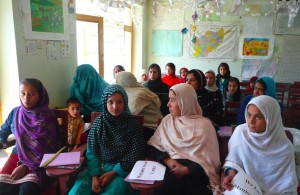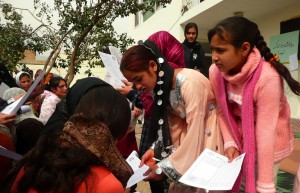Eliminating barriers against grassroots NGOs
First up, I must confess my ‘interest’ in this topic. I am co-secretary of the WA Branch of the Support Association for the Women of Afghanistan, SAWA. Founded in Adelaide, there are now SAWA groups in every State. We raise money for several projects, including a Vocational Training Centre in Kabul which educates women in literacy, computing skills, handicraft skills and English. The only money we raise that does not go to our causes is the auditor’s fees and postage for the newsletter. Our partner organisation in Afghanistan is OPAWC, the Organization for Promoting Afghan Women’s Capabilities. Because of their vision for women’s empowerment, OPAWC staff receive regular death threats from the Taliban and other fundamentalist forces. They describe their program of ’empowerment’ as not ‘short-lived or humanitarian’ but focused on improving the capacities of women, who only require ‘a door to walk through, and we are the ones who could help them and open the door and let them walk through it’.
In her book, Raising my Voice, Malalai Joya talks of warlords, drug lords and NGO lords. In the recent ABC 4 Corners program on Afghanistan, one commentator claimed that less than 5 per cent of the money promised after September 11 has actually gone to improve the lives of ordinary Afghans.
It is estimated that 40 per cent of the aid money is actually returned to rich donor countries as corporate profits, consultant salaries and other costs. Joya accuses members of the Afghan government of corruption. This is combined with the inefficiency of unwieldy bureaucracies. For example, up to 60 per cent of the money for the Kabul-Kandahar road was absorbed by the three intermediate layers of administration; the final inferior road was barely an improvement.
There are countless statistics like this. It breaks my heart that small NGOs like SAWA work so hard to raise a few hundred dollars here and there, that Australians on low and average incomes give the small amounts that they can spare, while the Australian government squanders millions of dollars in large-scale projects with accountability almost completely on paper, rather than long-term on-the-ground evaluation.
Furthermore, the forms of accountability chosen by AusAID disadvantages small NGOs. AusAID runs three programs which provide funds (a meagre 4 per cent of AusAID funding) for selected overseas aid-oriented NGOs:
- AusAID NGO Cooperation Program (ANCP) (for overseas aid oriented NGOs in Australia)
- Funding to Developing Country NGOs (for NGOs in foreign countries)
- Cooperation Agreements (CA) (partnership between AusAID and one or more Australian NGOs to deliver specific outcomes … for the broader Country/Sector strategy).
Under the first program, the accredited NGOs receive either $150,000 or $300,000 a year. A ‘small’ project receives up to $100,000 per annum. This signals an orientation towards medium to large NGOs. This is further suggested by the requirements for accreditation, including OAGDS (tax deductibility) status for at least one year and ‘a rigorous assessment of their organisational structure, systems and philosophies’. A great deal of documentation is required: copies of signed partnership agreements, evidence of capacity in project design, proof of appraisal, implementation, monitoring and evaluation capacity (describing its approach to each of these phases), description of monitoring and evaluation strategies. The organisational profile is a document of 120-150 pages, requiring around 6 months full-time work to complete (AusAID offers 5 days technical assistance).
Even achieving tax deductible status is more difficult for overseas-oriented NGOs than Australian charities. A charity set up to support a local football club merely has to register as an incorporated association in the state where it operates to achieve tax deductibility. By contrast, a charity established for overseas aid has to apply through the OAGDS scheme. This process takes a minimum of two years and has more requirements, including registering for fundraising activities in all Australian states and having as its major activity development and relief rather than welfare. ‘Welfare’ appears to mean assistance that does not have ‘a clear exit strategy’. Thus SAWA’s work to raise funds to pay teachers at the Vocational Training Centre is welfare rather than development because we do not envisage a time when the Centre will be self-funding. Tax deductibility also requires agreements signed by the Australian and overseas partners, inspection visits (generally twice a year), documented policies on handling grievances, counter terrorism and child sex tourism, and professional book-keeping.
While the NGO must achieve all of the above, companies can deduct donations to NGOs from their tax liability, even if these NGOs have not achieved tax deductibility status and/or the donation is for a welfare cause. Companies are allowed to do this as ‘good corporate citizen’ contributions. But why are private citizens not just as entitled to be rewarded as ‘good citizens’ with their donations?
So we have a bizarre situation where the programs that are evaluated according to government criteria are failing to deliver to the people of Afghanistan, while small NGO-to-NGO partnerships experience unintended discrimination. How can this be improved?
The following strategies would remove the barriers which more or less preclude small international aid NGOs from achieving tax deductibility status or accessing AusAID’s funding for NGOs:
- Introduce uniform requirements to achieve tax-deductibility status for domestic and overseas-oriented NGOs, i.e. incorporation as a charity. If businesses can be trusted to donate money appropriately, why not also trust ordinary citizens?
- AusAID introduces a new category of small internationally-oriented NGOs which can apply for an AusAID grant, up to a maximum of something like $25,000 to $50,000 per annum. The maximum might also be established pro rata, based on the amount raised by the organisation (e.g. a 1:3 ratio). The following rules should be considered:
1) An NGO must be in existence for two years before it can apply and raise a minimum amount of donations (e.g. $10,000 per annum)
2) Approval for annual assistance is based on a two page application supported with already existing documentation: such as annual reports, auditors’ reports, the Constitution, newsletters, reports from the field by the partner NGO, testimonials from participants in the projects overseas, reports of visits to the institutions/activities funded, including visual documentation such as photographs and videos.
Of course SAWA and other organisations like it cannot build the Kabul-Kandahar road and other infrastructure – more’s the pity, given the waste. But the more important infrastructural development, human capital, can be delivered by small partners working together who trust each other through ongoing personal relations. The evidence suggests that these small partnerships in the voluntary sector escape the inefficiencies and corruption of large bureaucracies and profit-oriented organisations.



We need all scales of aid – large, medium and small – as different needs are met by each of these.
Many other donor countries effectively support small NGOs and AusAID needs to learn from these. It is good that AusAID is concerned about effective processes but as the Independent Aid Review pointed out in order to increase aid effectiveness ‘the aim must be to manage rather than avoid risks.’
As Chilla has stated, the challenges facing the Afghan people, especially women, are extreme indeed.
Afghanistan remains one of the worst countries in the world to be born a woman. So we commend those organisations that work to make a difference in the lives of women in Afghanistan and we appreciate the challenges, including social, cultural and security challenges these organisations can face in undertaking this important work.
A central focus of Australia’s aid program in Afghanistan is to improve in education health and access to basic services – particularly for women. Despite the challenges that remain in Afghanistan there have been some remarkable gains in development and Australia is proud to have contributed to these. Australia has contributed to national education programs that have increased school enrolments from around one million in 2001 to more than seven million today, including for 2.5 million girls.
In Uruzgan Province, where Australia’s civilian and military effort is particularly concentrated, there has been a welcome increase in the number of schools, with around 200 schools now operating in the province, including 45 that are accessible for girls.
Australia’s flagship health and education program in Uruzgan Province is known as ‘Children of Uruzgan’, and is run by Save the Children. It aims to improve the lives of women and children in the province by providing better access to health and education services.
The Children of Uruzgan program is improving the quality and availability of education, for example, by increasing the number of female teachers and establishing 125 literacy and early childhood development groups for women.
While there is more to be done, our assistance is making a real difference in the lives of ordinary Afghans, particularly women.
To ensure these results continue, the Australian Government has put enormous effort into improving the effectiveness of the Australian aid program. In 2010 it commissioned the first independent review of the aid program in 15 years. The Government released a new aid policy last July as a result of the review – An Effective Aid Program for Australia: Making a real difference – Delivering real results.
We work with both multilaterals and NGOs across the aid program. Among the recommendations we have actioned out of the aid review is the completion of the Australian Multilateral Assessment – ranking the global agencies in the delivery of Australia’s aid on their effectiveness and relevance.
AusAID’s accreditation for non-government organisations is used as the basis for assessing NGOs and the agency is currently considering further means to improve this process for smaller organisations. This increase in funding to NGOs has seen the expansion of the AusAID NGO Cooperation Program (ANCP) Through ANCP we have provided grants to 43 accredited Australian NGOs and many of their in-country partners to deliver more than 600 poverty reduction projects in over 50 countries in 2011-12.
The expansion of the ANCP will enable more Australian NGOs to receive financial support, and to work in a direct partnership with the Australian Government. Increased funding to a more diverse range of Australian NGOs will provide even greater opportunities to extend the reach and effectiveness of Australian aid to benefit the most vulnerable people in the poorest communities in the world.
The aim of the Australian aid program is to make a real difference and to deliver real results. Part of this requires us to work with credible and effective partners. Next month AusAID will release a new Civil Society Engagement Framework that sets out approaches to reform accreditation of Australian NGOs to increase accessibility for small and niche civil society organisations. It also commits us to strengthen and institutionalise due diligence mechanisms for non-accredited, international and in-country (local) civil society organisations to facilitate engagement with a wider range of effective and accountable organisations. This is a new and exciting era in civil society engagement and we look forward to working with Australian NGOs, both big and small.
Thank you Margaret McKinnon for taking the time to respond to my blog. I am very pleased to read that AusAID is currently considering further means to improve this process for smaller organisations so that they can strengthen their partnerships with, often, small organisations overseas doing things that both partners can see is worthwhile.
I heard a Liberal politician say in parliament today or yesterday that the ALP government measures success by the money it spends. He was focusing on domestic matters like insulation and school buildings, but Julie Bishop has made the same point as shadow minister for foreign affairs in relation to aid. It is important to evaluate our achievements, not mainly by processing more paperwork but by gathering evidence on the ground, from those affected and ideally over the long term: a big ask I know, but the right ask to deliver successful aid.